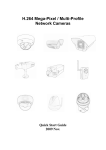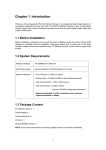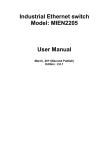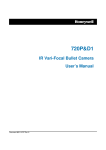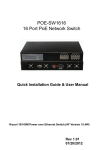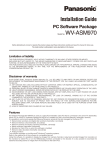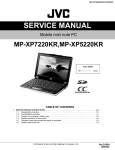Download H.264 Multi-Profile 1CH Video Server
Transcript
H.264 Multi-Profile 1CH Video Server Quick Start Guide 2013 Mar. About multi-profile Multi-profile stands for simultaneously video streams. These Network Cameras can generate H.264, MPEG4 and MJPEG streaming simultaneously to different clients. Moreover, the resolution can be different from one client to another. This state-of-art design is considerable to fit in various network environments. Before Installation Before installation, please be sure to read this quick installation guide and user’s manual carefully to complete machine installation. 1. System Requirements H.264 Multi-Profile 1CH Video Server Network Environment Network Interface 10/100MBase-TX Ethernet Monitoring System Recommended for Internet Explorer 8.0 or later System Hardware · CPU: Pentium 4, 3.6GHz or higher · Memory Size : 1GB or more · VGA card resolution : 1024 x 768 or higher - Sound card: for 2-way audio function System Requirement for Viewer & Recorder Application Support OS Win XP, Win Vista, Win 7, Win 8 System Hardware 16 cameras surveillance application (typical) · CPU: Intel Core 2 Quad 3GHz or higher · Memory Size : 2GB or more · VGA card resolution : 1024 x 768 or higher System Requirement for Viewer & Recorder Application Support OS Win XP, Vista, 7 FPS ~120 120~360 360~540 540~960 960~ (QVGA) CPU Intel P4 Intel P4 Intel Pentium D Intel core 2 Duo Intel core 2 Quad 2.4GHz 3.2GHz 950 E8600 Q9650 3.4GHZ 3.3GHZ 3.0GHZ RAM 512MB 512MB 1GB 2GB 2GB Display support1024x768 resolution or above Support DirectX 9.0c or above Intel 945G or Intel 965G or above 60GB (free space) Hard disk Ethernet 100Mbps Chipset 1Gbps Intel 945 or Intel 965 or above 2. Physical Installation 2.1 Connections Front Panel 2 LAN Socket The LAN socket is a RJ-45 connector for connections to 10Base-T or 100Base-TX Fast Ethernet cabling. This Ethernet port built N-Way protocol can detect or negotiate the transmission speed of the network automatically. Please use Category 5 cable to connect the Video Server to a 100Mbps Fast Ethernet switch or hub. In the LAN socket, there are two LEDs embedded: LAN LED (green color) This LED will be flashing while network accessing via Ethernet. Power LED (orange color) This LED is used to indicate whether DC power is on or not. Video-in Jack (BNC connector) You can Install 1 video camera and connect it to video-in jack. DI/DO/RS485 Connector The Video Server provides a terminal block with 6 pins of connectors for DIDO and RS485. Please refer to the Appendix A in this manual for more information. Cable for I/O connectors: Name Number Function VDC 1 12V DC output (50mA maximum) DI 2 Digital signal input GND 3 GND DO 4 Digital signal output 485+ 5 RS485 data + 4856 RS485 data - Back Panel MIC in (audio in) Connect an external microphone to the Video Server. Micro SD Card Slot User can insert a micro SD card into this slot for recording. 3 Factory Default Reset This button is hidden in the pinhole. This button is used to restore the all factory default settings. Sometimes restarting the Video Server will make the system back to a normal state. If the system still got problems after restart, user can restore the factory default settings and install it again. To restore the device, please follow the steps below: (i) Insert the paper clip or any proper tool and press and hold the button down continuously. (ii) Hold it at least 5 seconds and release the tool. Then the device has been restored to default settings and reboot again. Note: Restoring the factory default setting will lose the all previous settings included IP address forever. User needs to run the IPWizard II program to search the device and configure it to let the device work properly again. Audio/Video Output Jack Audio/Video-out Jack allows this device to output audio and video signal. Use the attached A/V cable to connect A/V device where white cable is for audio and yellow cable is for video. DC Power Jack (12VDC out) The function of this DC power jack depends on model: 2.1.1 Installation 1. Attach video source to Video Server To use this video server, user must supply video source to this device first. Typical, user may utilize box camera, doom camera, bullet camera, P/T/Z camera, Speed doom camera, or others as the video source. Connect an external camera to the device’s video input and make sure to power on these cameras first. Otherwise, the operation may be incorrect. 2. Attach external microphone to Video Server (option) If user needs not only video stream but also audio stream, then an external microphone should be attached to Video Server. Connect an external microphone to the Video Server’s audio input. 3. Plug an Ethernet cable into Video Server Connect an Ethernet cable to the LAN socket located on the device’s panel and attach it to the network. 4. Connect RS485 (option) When users would like to apply a camera with P/T/Z function, they usually need to connect their communication port (for camera control) through RS485. After RS-485 was correctly connected to D+ and D-, the remote users could control the camera movement through Internet. 5. Connect an external power supply to Video Server Connect an external power supply to the 12VDC power jack of the Video Server. Once you have installed the Video Server well, the Power LED (orange) will turn on later. It means the system is booting up successfully. Furthermore, if you have a proper network connection, and access to the Video Server, the LAN LED (green) will flash. 4 6. Connect DC power to one external camera from Video Server (option) In case your Video Server is connected to PoE switch, then this device can provide 12VDC out to supply one external camera thru 12VDC power jack. Note that the output current is 300mA maximum. 7. Done 3. Camera administration When you installed your networked device over your network environment, to start Network Camera web configuration, you must have the web browsers installed on computer for web management. - Microsoft internet Explorer 6.0 or higher At first, user may use “IP Wizard II” utility to search all networked devices in the LAN. Use “IP Wizard II” to locate IP address Press “Search” button. IP Wizard II will list all networked devices in the LAN: View function: If IP Wizard II finds network devices, View button will be available. Please select the device you want to view and click the View button. Furthermore you could double click the left button of mouse to link to the network device by browser. LAN setting function: The utility featured with “LAN” setting function to help user to modify the IP parameters of the installed network devices. User can step by step to setup IP address, username and password. 5 Note 1: If no IP address is assigned within 30 seconds, the networked device will automatically assign 192.168.0.100. User may now open your web browser, and key in http://192.168.0.100 in the address bar of you web browser to logon Network Camera’s web configuration page. Note 2: Power Line Frequency - If you found the video image is flash, you may need to choose 50 or 60 Hz frequency (depends on country). - World wide power line frequency table is inside user’s manual, Appendix Note 3: If you have problem when connecting the network camera to a router, please read user’s manual inside CD, the section “Installation to a router”. After connected to networked device, the device will prompt for User name and Password. For the first time, please enter: admin as username and no password to continue Web Management. If difficulty is met, please refer to the following steps to establish the connection: - The networked device must be installed and powered ON. - If the networked device’s default IP Address (192.168.0.100) is already used by another device, the other device must be turned OFF until the device is allocated a new IP Address during configuration. Made in Taiwan All Rights Reserved 2013 6






